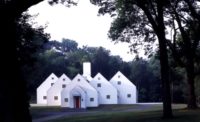If Hugh Hardy, who died last week at 84, had never designed anything but theaters—his specialty during a 50-year career—he would still be known as an architect of extraordinary range. That’s because his performance spaces varied radically, from the renovated Radio City Music Hall, where he captured the art deco exuberance of the 1930s, to the Polonsky Shakespeare Center, home to Theater for a New Audience, in Brooklyn. That stripped down, high-tech venue, utterly unlike Radio City or the other historic theaters that Hardy renovated, is an optical and acoustical triumph.
Mr. Hardy died of a cerebral hemorrhage Friday morning. On Wednesday evening, he had fallen while getting out cab before a performance at the Joyce Theater in Chelsea. Mr. Hardy had created the Joyce, a favored venue for dance performances, thirty-five years earlier.
Hardy did design more than theaters—he produced an exemplary visitor center at the New York Botanical Garden in the Bronx, a federal courthouse in Jackson, Miss., an apartment building at 4 West 21st Street (where he lived with his wife, Tiziana), and updated the interiors of two landmark restaurants, Windows on the World and the Rainbow Room. He also played a key role in the transformation of Bryant Park, which involved wholesale reconstruction of the grounds and buildings (1988 to 1992). Daniel Biederman, the founder of the Bryant Park Corporation, says, “anything you asked Hugh to do, he figured out a way to do.”
But theater remained Hardy’s great love. From 1958 to 1962, he was an assistant to Jo Mielziner, the set and lighting designer, who was working with Eero Saarinen on plans for the Vivian Beaumont Theater at Lincoln Center. After watching the two maestros, Hardy, who had studied architecture at Princeton (B. Arch. 1954; M.F.A. 1956) and served as a drafting instructor in the Army Corps of Engineers, decided to start his own architecture firm. (Almost 50 years later, Hardy designed a black box theater that rests atop the Beaumont. When it debuted, New York Times architecture critic Michael Kimmelman wrote, “Under the right circumstances, with a thoughtful, not wishy-washy architect, even an admired landmark by a historic figure can change. Mr. Hardy is that architect. And the city has a fine new theater to prove it.”
In addition to building theaters, Mr. Hardy built firms: Hugh Hardy & Associates, founded in 1962; Hardy Holzman Pfeiffer Associates, formed in 1967 with Malcolm Holzman and Norman Pfeiffer (and the winner of the prestigious AIA firm award in 1981); and H3 Hardy Collaboration Architecture, created in 2004. “It was important to him to have ‘collaboration’ in the firm name,” says one of Hardy’s partners, John Fontillas, who reeled off a list of H3’s current projects. He added, “We’re busy.”
Richard Olcott, a partner at Ennead who served on the city’s Landmarks Preservation Commission from 1996 to 2007, said that he always looked forward to Hardy’s appearances before the commission. “His presentations were theater: witty, entertaining, memorable,” said Olcott, and, not coincidentally, “the projects almost always got approved.”
Jeffrey Horowitz, the founding artistic director of Theater for a New Audience, said Hardy “loved the impact theater could have,” and knew how to maximize that impact. The Polonsky’s glass facade, which seems to float, was Hardy’s idea, he said. “Hugh wanted the building to reach out to the community.”
Fontillas said Hardy was always an optimist. Once, when the firm lost a competition, Hardy wrote Fontillas a note in which he urged him to “focus on the donut, not the hole.” “The important thing to him,” Fontillas said, “was moving forward.”
















